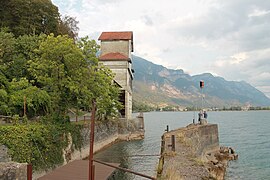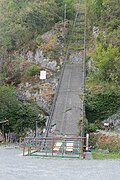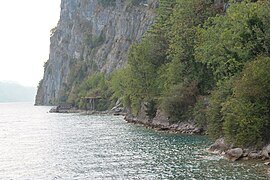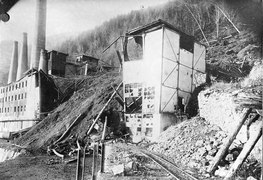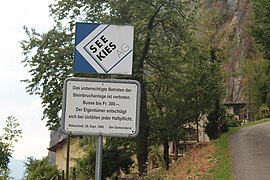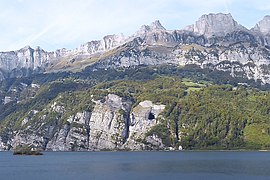Lochezen mine
The Lochezen mine was located on the northern bank of the Walensee in the area of the municipality of Walenstadt in the Swiss canton of St. Gallen
history
Already in early industrial times lime was mined on the north bank of the Walensee on the Churfirsten and lime kilns were operated on a small scale. This is evidenced by the name "Kaliforni" for the northern shore of Lake Walen in the area of the municipality of Walenstadt. «Forni» stands for «ovens». There was also a mill for grinding the quick lime on the Helgenbach .
In 1861, the predecessor company of the "Cement- und Kalkfabrik Unterterzen AG" was founded with the German mining engineer Heinrich Julius Tröger (1829–1892) heavily involved. The company traded as "Marble Quarries & Cement Factory Wallenstadt". The purpose of the company was stated to be “cement manufacture and delivery of marble”. Other shareholders were Franz Huber zu Bottle from St. Gallen and Jakob Götzger from Lindau. The stones and marble obtained were transported over a brick chute and a primitive toboggan run to two small shaft furnaces on the shore of Lake Walen, where they were burned with coke . The carved marble blocks were rolled down to the lake in a forest lane, causing a lot of damage to the precious stones. The material obtained was brought to Unterterzen by rowing and sailing boats . There the burnt lime was ground and transported for further processing by the existing railway.
Until the First World War
After Heinrich Julius Tröger's death in 1892, the company was restructured. The company was now called "Cementfabrik Wallenstadt Tröger & Götzger". The shareholders were Jakob Götzger and the widow Margareta Tröger-Götzger. In 1892 the company faced competition from the Seemühle to the north. In 1898 the license limits were set. A company called “Kunkler & CO” was founded by Theodor Kunkler from St. Gallen and Jules Huber from Walenstadt, which later operated as “Huber und Kunkler”. In 1896 the company received a water concession to operate a hydroelectric power station. In 1895 the young mining engineer Adolf Borner (1871–1966) was hired. He should massively expand the company. In the following years tunnels were driven into the mountain and lime kilns and rail networks were built. In 1897 Jacob Schmidheiny took over the majority of the company, which was now called "Wallenstadter-Roman- & Portland-Cementfabrik".
Schmidheiny invested in the company and the primitive toboggan run was replaced by a Bremsberg . Tracks were laid for a mine railway and a factory for grinding the burnt lime was built in Unterterzen. In 1899 Adolf Borner took a stake in the company together with an investor named Conrad Edelmann von Muolen. The company was now called "Borner Jun. Edelmann und Co." as a limited partnership . The latter built a cement factory on the banks of the Kaliforni, which was partially destroyed by a landslide in 1911. It was rumored that the landslide was caused by an improperly dimensioned blast. Adolf Borner sold the cement production including the cement quota for one million francs to the Schmidheinys, who relocated it to Unterterzen and built a new cement factory there. In 1915 Adolf Borner bought back the decommissioned and partially destroyed cement factory, including two rotary kilns. He was not allowed to produce cement because he had sold the quota. In 1916, the lime kiln was partially destroyed by another landslide, namely the part where cement production was located. The plant was not rebuilt because cement was no longer allowed to be produced anyway. From then on, hydraulic lime was produced. Schmidheiny's son Ernst continued the business during the First World War and relocated the lime distillery to Unterterzen.
Interwar period

The old kilns in Lochezen were demolished in 1919 after being badly damaged by a landslide in 1914. In the meantime, the Schmidheinys had Ledischiffe built in order to be able to transport the raw material from Lochezen to Unterterzen. For this they built a modern loading station and a small port in Lochezen. The Schmidheinys rose to become one of the largest cement producers in Switzerland. The mine and the cement factory were henceforth called "Cement- und Kalkfabrik Unterterzen AG" for short "CKU".
In World War II
During the Second World War , an underground military hospital was built in 1941 in the old caverns of Lochezen, consisting of 25 wooden barracks as part of the Sargans fortress belt . The hospital was equipped for 280 patients. Military cableway SB 18, and several served for the transportation of casualties military cableways on any possible castling axis (as an alternative to Kerenzerberg ) over the Riseten- and Pragelpass into Muotatal . The military also built a small boathouse for motor boats to transport patients. In 1949 the hospital barracks were sold and dismantled. Only the foundations have been preserved. The Schmidheinys continued to expand production during and after the war. A modern mine railway with battery-powered locomotives was created.
post war period
In 1956, a wide-gauge inclined elevator with a track width of almost three meters was built. Meanwhile, the Seemühle traded as “Borner AG”, but business was not going well. The demand for lime had fallen and «Borner AG» was not allowed to produce cement. The machines were shut down in 1963 and the company filed for bankruptcy in 1964 . The entire property was previously sold to a «Kalkfabrik Walenstadt AG». But this company no longer started operating the lime mine. In 1968 the facilities and buildings were blown up by the Swiss Army , which operates a weapons yard in Walenstadt. One remembered the vineyards that had existed on this southern slope before limestone mining.
Todays use
Today the land is owned by the municipality of Walenstadt and the Swiss Army. Wine is grown on the “Kaliforni” and the local community of Walenstadt has set up an educational forest trail.
The current testing facility in Lochezen was also built. Geobrugg-Fatzer AG and the Federal Office for the Environment have been operating the world's only test center for rockfall nets on the site of the former mine there since 2004 .
The local community of Walenstadt offers 2-hour guided tours for those interested. A tour without a knowledgeable guide is not possible. There is a risk of falling rocks. There are fears that the steep slopes of the Churfirsten, which have become unstable due to mining activities, could slide into the Walensee and trigger a tsunami .
literature
- Cement- und Kalkfabrik Unterterzen (cement factory) - Quarten: Document collection 1966.
Web pages
- sarganserland-walensee.ch History and pictures of the Seemühle and Lochezen mines
- sarganserland-walensee.ch Systematic photo documentation (also underground) of the two mines Seemühle and Lochezen
Individual evidence
- ^ Paul Gubser: Walenstadt. In: Historical Lexicon of Switzerland . August 28, 2013 , accessed September 3, 2018 .
- ↑ KPH 2 / 15.2.008 Widebach, Mülibach and Walensee (Seez and Walensee river areas): Water rights concession for the waterworks at Widebach in Walenstadt and for the Huber & Kunkler Seemühle in Kaliforni (municipality of Walenstadt), situation plan, 1896 (document) . St. Gallen State Archives, accessed on September 3, 2018 .
- ^ Paul Gubser: Quarten. In: Historical Lexicon of Switzerland . December 16, 2011 , accessed September 3, 2018 .
- ↑ Annual Report 2011 Holcim Ltd. (PDF; 10.6 MB) Holcim Ltd, p. 25 , accessed on September 3, 2018 .
- ↑ Guido Städler: The end of the last Ledischiff. In: Southeastern Switzerland . September 14, 2014, accessed September 3, 2018 .
- ↑ 8880.01 Walenstadt Lochezen - quarry. standseilbahnen.ch, Markus Seitz, accessed on September 3, 2018 .
- ↑ a b Lochezen quarry. Walenstadt parish, accessed on September 3, 2018 .
- ↑ Walenstadt educational forest trail. Walenstadt parish, accessed on September 3, 2018 .
- ↑ mai / mgt: When 20 tons of concrete go into the net. In: Baublatt . October 11, 2011, accessed September 3, 2018 .
- ↑ Lochezen quarry, Walenstadt. (PDF; 173 kB) Office for Culture Canton St. Gallen, accessed on September 3, 2018 .
- ↑ jeh: Riddle about falling rocks at Lake Walen. In: 20 minutes . October 12, 2017, accessed September 3, 2018 .



